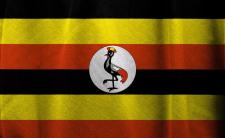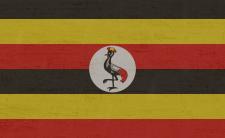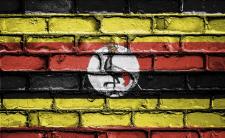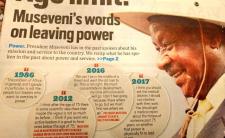The Republic of Uganda is bordered on the east by Kenya, on the southeast by Lake Victoria, on the south by Tanzania and Rwanda, on the west by Zaire, and on the north by Sudan. It is also predominantly Roman Catholic country with many different co existing ethnic groups. Uganda has undergone a turbulent constitutional history with up to four constitutions since gaining independence from the United Kingdom.
Constitutional history
Before the British and Germans contended for control over the territory, Uganda had three different indigenous political systems: the Hima caste system, the Bunyoro royal clan system and the Buganda kingship system. In 1894, the British succeeded in establishing a protectorate and made the Buganda, also called the people of Buganda, administrators competent to collect taxes. A British-style high court of Uganda and an appeals court for all eastern African protectorates were established in 1902. At the same time, a special commissioner was installed to perform executive, legislative and judicial powers. In 1955, a constitutional monarchy with a ministerial government based on the British model and in 1957 political parties emerged and direct elections were held.
Uganda became an independent Commonwealth nation on October 9, 1962 under a constitution much influenced by the British. The constitution distributed powers between the centre and the regions, albeit disproportionately. The Buganda kingdom was given more powers at the expense of the other three kingdoms, namely the Ankole, Toro and Bunyoro, and the other districts. The powers granted to the four kingdoms also handicapped the Parliament, which was elected by direct universal suffrage, except for parliamentarians from Buganda who were indirectly elected through the Council of Buganda. Apart from the periodically elected Parliament, the constitution provided for a Cabinet, drawn from and responsible to Parliament, and defined the powers of major government organs, civil service and judiciary. One year later, an amendment introduced a ceremonial President to replace the Governor General as a head of state and Kabaka Mutesa became the first elected president on 9 October 1963.
The 1962 constitution was abrogated by Prime Minister Milton Obote in 1966, who declared himself President under an Interim Constitution of 1966. The Parliament was constituted into a Constituent Assembly and given a mandate to draft a new constitution for Uganda. On September 8, 1967, the new constitution came into force. It extended the life of the Parliament, declared the President then in office the President of Uganda for a term of 5 years. Other major changes by this constitution were the abolishment of the kingdoms and the introduction of a more centralized system of government. The election of Members of Parliament remained by direct universal suffrage across the entire country but the President was now elected indirectly by the Parliament. Although the system of government had some democratic semblance, democratic principles were hardly observed in practice, and Obote ruled basically with army support. Shortly after the constitution of 1967, a state of emergency was declared and Uganda slowly shifted to one-party-rule under the Uganda People’s Congress.
In 1971, General Idi Amin Dada seized power. Amin ruled the country through constitutional decrees and used the army as the main instrument of government. In 1979, Amin, too, was overthrown by a combination of Ugandan and Tanzanian forces. In the following years, the Ugandan military continued to participate actively in Ugandan political processes. In 1985 Obote was again elected president, but only to be deposed a year later by the Museveni-led National Resistance Movement – a rebel movement that had been fighting the regime for years.
On 21 December 1988 the National Resistance Council (NRC) enacted Statute No.5 of 1988 which established the Uganda Constitutional Commission and gave it responsibility to start the process of developing a new Constitution. The mandate of the Commission was to consult the people and make proposals for a democratic permanent constitution based on national consensus. In its final report of December 1992, the Commission stated that the majority of Ugandans preferred a Constituent Assembly directly elected by the people in order to be as full representative as possible and provide greater legitimacy. It proposed that an Assembly should be composed mainly of directly elected delegates plus representatives of some interest groups. The proposal was accepted by government and thus the Constituent Assembly consisted of 284 delegates elected by universal suffrage representing 214 electoral areas designated plus additional representatives of specific stakeholders. Nevertheless, some people feared that the delegates to the Constituent Assembly might tailor the constitution to suit their future political ambitions.
The elections to the Constituent Assembly took place in March 1994. Every registered voter who did not have a criminal record and could afford the required nominators and financial deposit was able to run for office. Apart from the decisions relating to national language, land, federalism and the political system, all provisions of the draft constitution were reached by consensus. The land question in Uganda emerged when the British took land away from the communities and gave it to a few individuals and was not resolved by the Constituent Assembly. The debate about the political system, on the other hand, was rooted in the bad experience of Ugandans with political parties in the post-independence era. On this basis, a “no party” politics, also known as “movement politics”, was proposed. In this system, no one is denied the right to run for any political office of his or her choice. The stress is on personal merit and political parties are permitted to exist but are forbidden from electoral campaigning and sponsoring candidates. Movement politics were strictly opposed by multiparty supporters. As a compromise, the movement type of governance was agreed to be extended for another 5 years but at the end of 3 years a public debate should be held and after 4 years, the people of Uganda should choose between the two systems in a referendum. On the whole, the constitution making process in Uganda was highly participatory and an exercise to reconcile the society, reinstitute democracy, the rule of law and to place limits on misuse of state power.
1995 Constitution
On September 27, 1995, the Constituent Assembly adopted the new constitution. The 1995 constitution, establishes a quasi-parliamentary system of government, consisting of a President, Prime Minster, Cabinet, unicameral Parliament, Supreme Court and Constitutional Court. The preamble states that the constitution shall be based on the “principles of unity, peace, quality, democracy, social justice and progress” and includes a long chapter on “National Objectives and Directive Principles of State Policy”. Moreover, Article one of the constitution proclaims the sovereignty of the people and according to article 2, the constitution “shall have binding force on all authorities and persons throughout Uganda”. The constitution stresses the importance of the protection of human rights by stating that “fundamental rights and freedoms of the individual are inherent and not granted by the State” and guarantees specific rights and freedoms like, amongst others, the freedom from discrimination, freedom of religion, the prohibition of torture and slavery, the right to privacy, assembly and association.
In opposition to the Constitution of 1967, the current constitution contains a whole range of powers that are shared between the President, Parliament and other constitutional bodies. Amongst others, the presidential power of appointment regarding the Vice President and Ministers is subject to the approval of the Parliament and the appointment of Permanent Secretaries and heads of departments have to be made upon recommendation of the Public Service Commission. The Public Service Commission moreover has the power to appoint all other civil servants and judicial officers other than Judges of the High Court, Court of Appeal and the Supreme Court are appointed by the Judicial Service Commission. Also in other areas the power of the executive has been cut down extremely: The President no longer has the power to dissolve Parliament and in the area of legislation the Parliament can over-ride the presidential veto by two-thirds majority. The executive’s powers to borrow money are also limited since Parliament now first has to approve borrowing.
In 2000 and 2005, important referenda on the system of government took place: The first referendum favored a “no-party” system of government but was invalidated by a court ruling some years after because of procedural shortcomings, whilst the second referendum approved a multiparty system and abolished the two-term limitation on the presidency.
The Executive
As set forth in article 98, the President of the Republic of Uganda is the Head of State, the Head of Government and Commander in Chief of the Armed Forces. Presidential candidates must be citizens of Uganda, between thirty-five and seventy five years of age, and qualified to be a member of parliament. In order to be nominated, a presidential candidate must be supported by one hundred voters in at least two-thirds of all Ugandan districts. He is elected by universal adult suffrage for a five years term. In case one candidate is not able to obtain more than half of the votes cast in the first run, a runoff election takes place between the two presidential candidates who obtained the most votes. The President has precedence over all other persons in Uganda and is obliged to safeguard the constitution as well as “execute and maintain the Constitution and all laws”. Moreover, he has the power to appoint a Vice President after having obtained the approval of the legislature. To be removed, an action for “abuse of office” or certain “misconduct or misbehavior” may be enforced by one third of all the members of parliament. After a special tribunal has investigated the case, a majority of two thirds of the members of parliament has then the power to confirm the decision on the removal of the President. The Cabinet, determining, formulating and implementing the policy of the Government, is formed of the President, the Vice President, the Prime Minister and the Ministers. The total number of Cabinet Ministers shall not exceed the total number of twenty-one except with the approval of Parliament.
The Legislature
The unicameral Parliament, a body of directly elected members to represent constituencies, has the power to make laws on any matter “for the peace, order, development and good governance of Uganda”. Members of Parliament serve for a five-year term and according to article 80 must be citizens of Uganda, registered voters and have obtained “a minimum formal education of Advanced Level standard or its equivalent”. Subsection 2 of article 80 then lists reasons disqualifying a person for parliamentary elections, such as being of unsound mind, holding an office with election responsibilities, having been declared bankrupt or being a “traditional or cultural leader” as defined in article 246 of the Constitution. Article 78 moreover stipulates that Parliament shall include one woman representative per district and a certain number of representatives of “the army, youth, workers, persons with disabilities” and certain other groups as determined by Parliament. The vice president and the cabinet ministers become ex officio members of parliament without the right to vote. Generally, bills are passed by a majority of those present and voting and must be presented to the President for assent. The President has the power to return bills for reconsideration or refuse assent in writing. If the Parliament adopts the bill a second time and presents it to the President, the President may return it once more. In order to overrule the President’s objection, the Parliament has to pass the respective bill once more by a two-thirds majority of all members. In case the President remains inactive on a bill for more than thirty days, presidential assent is presumed.
The Judiciary
Article 126 lays down that “the exercise of judicial power is derived from the people”. The constitution stresses the motion of an independent judiciary and article 127 provides for the participation of the people in the administration of justice. The judiciary consists of the Supreme Court, Court of Appeal and the High Court. The Parliament may establish further courts by law, including so called “qadhis courts”, which shall be able to hear cases regarding marriage, divorce, inheritance of property and guardianship.
The Supreme Court is the final court of appeal and consists of a Chief Justice and at least six other Justices. A case is decided by a quorum of any uneven number not being less than five members of the Court. Previous decisions of the Supreme Court are usually binding on the Court itself and all other courts. However, according to article 132, the Court may depart from a previous decision when it “appears right to do so”. When the Supreme Court hears appeals from decisions of the Court of Appeal sitting as a Constitutional Court all the members of the Supreme Court have to be present.
Regarding questions as to the interpretation of the Constitution, the Court of Appeal sits as a Constitutional Court with a bench of five of its members. The Constitutional Court, which is not expressly mentioned as a court of judicature in article 129, has the power to interpret the constitution. Any person alleging an infringement of the Constitution as laid down in article 137 may petition the Court for a declaration to that effect. The Court may then grant an order of redress or refer the matter to the High Court to investigate and determine the latter. Questions as to the interpretation of the constitution can also be referred by other courts of law.
| Branch | Hierarchy | Appointment | Powers | Removal |
|---|




